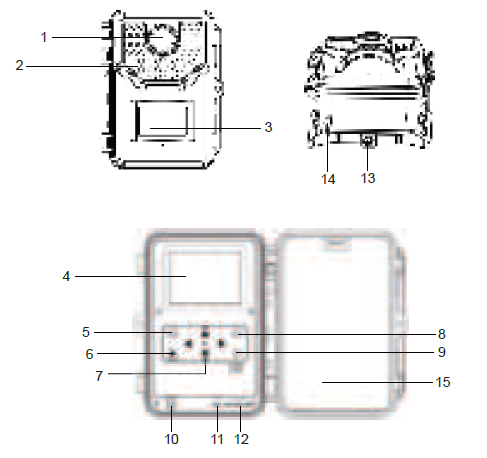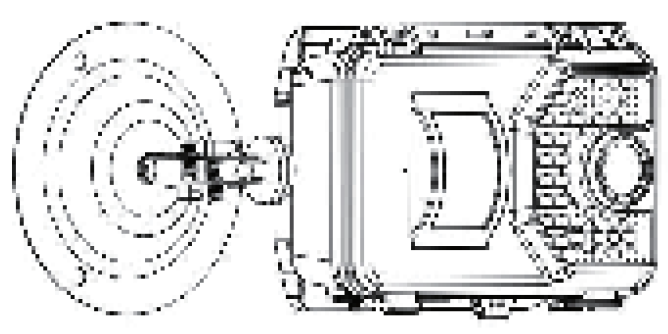Vikeri Trail Camera E2 User Manual

Vikeri Trail Camera E2 User Manual
Few Words From VIKERI
First of all, thank you for choosing . We are grateful for your trust in our products. VIKERI has been studied cameras for decades. We have continuously designed several models of trail camera for different needs based on our research. We engage to provide the right product to the right customer. VIKERI believes in Connection. We would like to build a little lovely community where we could connect with each other and share our lives, our emotions, our experience, our joy, and our sadness. Thank you for joining us.welcome to VIKERI
Product Introduction
E2 Trail Camera is an advanced model for daily use. If you are interested in wildlife monitoring or you would like to see who are the secret visitors in your garden, E2 Trail Camera is the perfect choice for you.
Structure
- Lens
- Infrared LEDs
- PIR motion sensor
- LCD screen
- Menu button
- Replay button
- Navigation buttons
- Shot button
- OK button
- TF card slot
- USB slot
- Operating mode switch
- Fixation port
- 6V 1.5A Power supply port
- Battery slots
| Key | Function |
| MENU | Press to open or close the menu |
| REPLAY | Press to preview photos and videos on LCD screen |
| Up | Navigation Up (in Menu mode); View previous photo/video (in Playback mode); Switch to Video (in Setup mode) |
| Down | Navigation Down (in Menu mode); View next photo/video (in Playback mode); Switch to Photo (in Setup mode) |
| Left | Navigation Left (in Menu mode) |
| Right | Navigation Right (in Menu mode) |
| SHOT | Press to take picture/record video (in Setup mode) |
| OK | Start/Stop playing video file (Playback mode); Confirm/Enter (in Menu mode) |
Components
- Micro USB Cable
- Fixation Kit
- Installation Belt
Parameter
|
Photo Resolution |
16MP/12MP/8MP/5MP |
|
Video Resolution |
1080P/720P/D1/VGA |
|
Detection Angle |
Up to 120 ° |
|
Detection Distance |
80ft (day), 65ft (night) |
| Fill Light LED Wavelength | 940nm (No Glow) |
| Fill Light LED Quantity | 48 pcs |
|
Trigger Time |
0.2s – 0.5s |
| Waterproof Level | IP66 |
|
Working Temperature |
– 4°F – 160°F |
| Memory Card Type | Up to 32G TF Card (Class 10) |
| Power Supply Type | Battery/External |
|
Battery Type |
AA Battery |
|
Working Voltage |
6V |
|
External Power Supply |
DC 6V |
|
Standby Time |
Up to 6 Months |
| Photo Format | JPEG |
Function
| Mode |
You could choose the working mode of E2 |
Photos (default) Videos Photos &
Videos |
| 16MP | ||
| Photo | You can choose different photo | 12MP |
| Resolution | resolution | 8MP |
| 5MP (default) |
| Photo Series | You can set the photo quantity when the camera is activated | 1 photo (default)
2 photos in series 3 photos in series |
| Video Resolution | You can choose different video resolution | 1920*1080P
1280*720P (default) 720*480P 640*480P |
| TL Video(1) Resolution | You can choose the resolution of time lapse video | 2592*1944P
2048*1536P (default) |
| Video Length | You can adjust the video length | 10 seconds (default)
3 seconds min. 10 minutes max. |
| Audio
Recording |
You can decide if you want the
camera to record sounds |
On (default)
Off |
| Shot Lag | The time interval between each trigger (2) | 30 seconds (default)
2 seconds min. 60 minutes max. |
| IR Distance | You can choose the IR distance. Further you choose, further the camera could detect, but the
battery runs faster |
Near Middle (default)
Far |
| Sensitivity Motion Sensors | You can adjust the sensitivity of the motion detection sensor. | Low Middle (default)
High |
| Target
Recording Time(3) |
You can set the camera to record between a certain period | On (to set the period)
Off (default) |
| Time Lapse(4) | Set up time lapse mode and the length of the lapse. | Normal TL video
Off (default) |
| Language | To set different language | English (defalut), Deutsch, Dansk, Suomi, Svenska, Español, Français, Italiano, Nederlands, Portugués,
|
| Endless Capture | If Endless Capture mode is on, the camera won’t stop recording when the memory card is full but will delete the oldest videos or photos to keep recording continuously | On
Off (default) |
| Time & Date | To set time and date. You can also choose the time format (24h or 12h) and choose the date format (dd/mm/yyyy,
yyyy/mm/dd or mm/dd/yyyy) |
Set Time & Date
Time Format Date Format |
| Photo Stamp | To choose if there will be time and date on the photo. | Time & Date (default) Date
Off |
| Password
Protection |
Set up password to secure your
camera |
On
Off (default) |
| Beep Sound | Turn on or turn off the operation
sound |
On (default)
Off |
| Format Memory Card | Decision with caution! You will lose all of the data in the memory card if you decide to format it | Yes
No (default) |
| Serial NO | To set up the serial number of
the camera(5) |
On
Off (default) |
| Reset
Settings |
Reset all the settings to the
original settings |
Yes
No (default) |
- TL Video: Time lapse video. Camera will first of all, take photos between certain period (set up in “Target Recording Time” and “Time Lapse”), then the camera will generate a video with these photos. This function usually used to record flower bloom.
- For example, we set the 1 minute video length and 30 seconds shot lag. When the camera detect an animal, it will start to record a 1-minute video. However, the camera will not detect continuously. When the video is done, the camera will not detect immediately. It will detect again 30 seconds after the video in order to save the battery.
- In order to use the “Target Recording Time” function, please make sure that you have already turn off the “Time Lapse” function and set up the length of the lapse between each photo.
- If you turn on the “Time Lapse” and turn off the “Target Recording Time”, the camera will take photos until the memory card is full.
- If you use several cameras at the same time and you want to recognize which camera took which photos and videos, set up a serial number could help you. The serial number will show on the bottom right of the photos or videos.
Operation
Getting Started
As the Trail Camera doesn’t have built-in memory, a Micro SD memory card must be inserted into the camera before using.
1.1.Open the camera by unlocking two side locks.1.2.Open the battery compartment.1.3.Place 4 or 8 AA 1.5V type alkaline batteries into slots.NOTE: Must be alkaline. If you have only 4 AA alkaline batteries, and make sure to place them all in the upper or lower half of the battery compartment.1.4.Insert Micro SD memory card.

Please note:
- TF high-speed card (Micro SD memory card) of Class 10 is required for this camera.
- This camera is compatible for using Micro SD (TF) cards with a capacity up to 32GB.
- Please format your Micro SD (TF) card before the first use.
- Camera must be turned off before inserting or taking out the memory card.
- Do not take out Micro SD (TF) card or disconnect the camera from USB port while formatting the card or transferring data to your computer, otherwise recorded data and memory card may become damaged.
Operating
As soon as you have inserted the batteries and a Micro SD card, the camera is ready for work! All you need to do is to choose a position for it and turn it on by setting the operating mode switch to ON.
The camera has the following default settings:
- Mode: Photo
- Photo resolution: 5MP
- Photo series: 1 photo
- Video resolution: 1280x720P
- Video length: 10 seconds
- Audio recording: On
- Shot lag: 30 seconds
- Motion sensor sensitivity: Middle
- Target recording time: Off
- Time lapse: Off
With the default settings, the camera will first take 1 photos when its motion sensor detects a moving object. Please note that If you want sharper image quality, you can turn up the resolution, however photo and video files created with these settings will take more space on memory card.
For instance,4GB Micro SD (TF) card can store about 140 photos plus 70 videos (10 sec each) with the default settings. Therefore if you are using a small capacity Micro SD (TF) card, or considering to set your camera for a longer period of time, you might want to reduce photo and/or video resolution in the Settings.
Positioning the Camera
In TEST mode you can work out the best exposure angle and range of the motion sensor. First put the operating mode switch to TEST, then align the camera as follows:
Fasten the camera to a tree or any other suitable object using the included strap and align the camera in the desired direction. Then move slowly from one side of the target area to another. While doing this, watch the indicator located between IR LEDs.
If the red indicator lights up, you have been detected by the motion sensor. This way you can find the best position for the camera. The detecting range of the sensor is 120°.
NOTE: Setting the camera too close to tree branches can result in many “empty” photos as the motion sensor will detect movements of tree branches and leaves. You can also adjust the sensor sensitivity to the lower level to avoid irrelevant triggering.
Turning on the Camera
To turn on the camera, set the operating mode switch to ON. You will see a blinking blue indicator on the front panel. After 15 seconds the camera will start to operate independently and will go into standby mode. As soon as any object enters the detecting range of the motion sensor, the camera will be activated and will start capturing photos and/or videos (depending on the selected setup).
When the object moves out of the detecting range of the motion sensor, the camera will go back into standby mode.In the nighttime, infrared LEDs will provide the required light for capturing photos/videos.The effective range of the IR LEDs is 10- 65ft.Pictures and videos taken at night are black and white.
NOTE: During the night, camera will use more energy for IR LEDs. Therefore, if the battery is low (Less than 1/2),the camera will not take photos or shoot videos at night, while in the daytime, the camera will work normally even with a low battery.
Playback
You can quickly preview recorded photos and videos on LCD screen. Open the camera by unlocking two side locks and set the operating mode switch to the TEST position. Press REPLAY key and Up/Down navigation keys to review the photos/videos. To play videos, press OK key to start playing and press OK again to stop. Press REPLAY key to return back to standby.
Delete Selected Files
You can use this function to delete photos/video recordings from the memory card. Find the file you want to delete in REPLAY mode, then press MENU key, select “Delete current file” and press OK to delete the selected recording.
Delete All Files
You can delete all recordings from the memory card by pressing MENU key when in REPLAY mode, then select “Delete all files” and press OK.
Activate Slide Show
For an automatic review of the photos and videos stored on the memory card, press MENU in REPLAY mode, and select “Activate Slide Show”. Each photo/video will be displayed for about 2 seconds. To stop the slide show and keep the current image on the screen, press the OK button.
Write Protection
This function can be used to protect individual files from accidental deletion. When in REPLAY mode, press MENU and select “Write protect,” then choose “Write-protect current file” to protect the selected photo/video. Select “Write-protect all files” to protect all recordings from accidental deletion. Select “Unlock current file” to remove write protection for the selected recording.
Select “Unlock all files” to remove write protection for all saved recordings.
Installation
If you want to put the camera on the wall, the Fixation Kit is ready for you:
- Mark the installation position with the help of the metal plate and make holes in the wall;

- Put the green components in the holes;

- Fix the Fixation Kit by following the picture;

- Put the camera at the position you have chosen and fix the camera with screws;

If you want to Install the camera on a tree, you could simply use the Installation Belt:
- Pass the Installation Belt through the support on the back of the camera. If the Belt is too long for the tree which you choose, there are 3 holes on each side the support, you could pass the Installation Belt through several holes to shorten the belt;

- Put the camera on the bottom of the tree;
- Go to the other side of the tree, pass the belt through the buckles by following the picture;

- Adjust the position of the camera then tighten the belt;
- If you afraid that the camera would fall, you could also use the Fixation Kit and the Installation Belt together to make sure that the camera is sturdily fixed on the right position.
QA
1. I can’t turn on my camera!
- Please check if the batteries is full power;
- Please check if battery polarity is correct;
- Please re-install the batteries.
2. My camera is not taking photos or recording videos!
- Check if the TF card is Class 10;
- Check if the TF card works normally on other devices;
- Format the TF card.
3. The camera doesn’t detect anything!
- Please make sure that the camera is not behind the glass;
- Please check the setting in the menu to adjust the detection distance and the detection sensibility of the camera then try again.
4. Why the camera doesn’t record during the night but it works well during day time!
- Please check the battery level of the camera. If the battery is low (1/3 of the full battery), the night vision function will automatically shut down. Please change the batteries then the night vision function will restore.
5. My “Target Recording Time” function doesn’t work!
- Please check if you have also turned on the “Time Lapse” function and have chosen the time lapse mode then set up the lapse length.
Precaution
- Do not dip the camera in the water.
- The camera can work under 160°F but please keep the camera far enough from fire to protect batteries.
- Alkaline batteries are strongly recommended because alkaline batteries are able to provide strong and stable power to the camera.
- Please do not mix old batteries and new batteries.
- If an DC 6V power adapter is used to supply the camera, please make sure there are no batteries in the camera in order to prevent the overcharge.
Warranty
In the spirit of “high quality, service, and development”, with the concept of “quality products, reasonable prices, and considerate service” and the principle of responsibility and openness. We solemnly promises you: We guarantees that the manufactured products are produced and inspected in accordance with the relevant national standards. Substandard products will never leave the factory. Guarantee strict performance and fulfillment of product warranty, and strictly enjoy the relevant regulations of professional service.
To get extra 12-month warranty, total 24 months, please contact official service team:
Email: [email protected] ,and provide information(order number, product name).When the trail camera is replaced, the warranty will still be the original trail camera you bought. You may return the product after first obtaining a Return Material Authorization number and following any other guidelines.

FAQS
Press and hold the “OK” key until you hear a beep.
Press and hold the “OK” key until you hear a beep.
Press and hold the “Shot” button until you hear a beep.
Press and hold the “Shot” button until you hear a beep. Release the button when you are ready to record video. To stop recording, press and hold the “Shot” button again until you hear a beep.
Connect the included USB cable to an AC adapter or computer with USB port, then connect it to the E2 trail camera’s USB slot. The red light will turn on when charging. It takes about 3 hours to fully charge it. The red light will turn off when charging is completed. Please use only VIKERI brand AC adapter for charging. Other brand AC adapter may cause malfunction of E2 trail camera due to voltage difference between AC adapter and E2 trail camera’s input voltage (6V).
It takes about 3 hours to fully charge it with 1.5A AC adapter (not included). If you want to use your computer as a power source, please use 1A or less AC adapter for charging so that it would not damage your computer’s USB port due to high current flow during charging. If you are using your computer as a power source, please make sure that your computer is turned on during charging. Otherwise, it would not be able to draw enough power from your computer during charging process due to its low power consumption while in sleep mode with no load connected to its USB port. We suggest using 1A or less AC adapter for charging so that it would not damage your computer’s USB port due to high current flow during charging. If you are using your computer as a power source, please make sure that your computer is turned on during charging. Otherwise, it would not be able to draw enough power from your computer during charging process due to its low power consumption while in sleep mode with no load connected to its USB port. We suggest using 1A or less AC adapter for charging so that it would not damage your computer’s USB port due to high current flow during charging. If you are using your computer as a power source, please make sure that your computer is turned on during charging. Otherwise, it would not be able to draw enough power from your computer during charging process due to its low power consumption while in sleep mode with no load connected to its USB port. We suggest using 1A or less AC adapter for charging so that it would not damage your
Many wildlife game cameras shoot standard-definition quality, but the good ones record 720p and high-quality 1080p videos. Video clip length varies from 30 to 90 seconds. If you want to capture wildlife’s natural sounds, you’ll have to choose a camera with a microphone and audio recording.
Remove the batteries. Wait 60 seconds and re-insert. Press and hold the power button for 30 seconds. Press the reset button, if your trail camera has one.
Trail cameras can shoot 20,000 photos on a set of batteries. And last as long as 8-12 months. Some factors affecting battery life include shooting video, using rechargeable batteries, temperature, night shooting, and trigger delay.
This “zone” is where the camera detects movement.
Range: Different trail cameras have varying ranges that determine how far away they take photos. Ranges can vary from 20 feet to 80 feet. Multi-shot mode: Some cameras have a feature that takes multiple pictures after sensing movement.
Most minor troubles with trail cameras are due to the batteries not providing enough power. This can be down to the type of batteries being used or simply that they are getting low and need replacing.
If you live in an area that hosts sub-zero temperatures, chances are the less expensive trail cameras aren’t going to cut it. They usually stop working somewhere between 0-10 degrees Fahrenheit.
Camera. The camera is one of the most important pieces of hardware on a phone. However, it also has the capacity to drain the battery quite a bit.
While there’s no set height, and you may occasionally need to get lower to avoid limbs, it’s usually best to keep cameras at a deer’s height — about 3 feet tall. If you feel deer will be alarmed by the camera’s presence, you can place them 6 to 7 feet higher and out of their line-of-sight.
This is the most common and most basic setting that all trail cameras have. This mode will take still images of animals during both day and night when triggered by movement in front of the camera.
VIDEO

References
[xyz-ips snippet=”download-snippet”]








